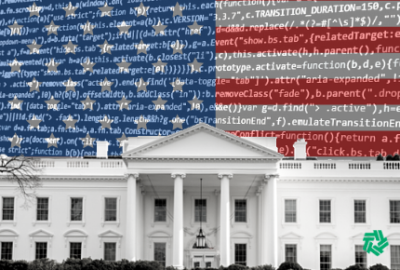
Agencies getting on board with TMF as expedited review deadline nears
Federal Chief Information Officer Clare Martorana said OMB is working on new 21st Century IDEA Act guidance and a new IT modernization strategy.
The Federal Trade Commission is putting the final touches on its proposal to obtain some of the $1 billion Congress added to the Technology Modernization Fund.
Raghav Vajjhala, the FTC chief information officer and chief data officer, said at the Professional Services Council’s Tech Trends conference on May 25 that offering flexibilities around the payback model provided more reason to submit a business case to the TMF board.
“There are a variety of agencies that have something akin to a working capital fund in the first place, so removing that was a big incentive,” Vajjhala said. “The other thing that I think OMB has learned a lot from the old development, modernization and enhancement (DME) and operations and maintenance (O&M) reporting days and the old OMB 300s, it created a weird incentive where you would get less paperwork if you chose not to modernize. I think the new model that they put out for the modernization fund is trying to streamline the overhead and bureaucracy of the process so they are trying to encourage more good ideas up front as much as they can.”
The FTC likely will submit one of about 100 proposals the TMF Board expects to receive on or about June 2, which is the deadline for agencies to receive expedited consideration.
The Office of Management and Budget issued new guidance for the TMF on May 4 outlining two new options for repayment — partial of anywhere from 25-to-75% and minimal repayment.
The FTC isn’t the only agency rethinking about applying for TMF funds.
Steve Wallace, the systems innovation scientist for the emerging technologies directorate at the Defense Information Systems Agency, said the repayment policy changes also is leading his agency to reassess how the TMF could help them meet their technology modernization needs.
Federal Chief Information Officer Clare Martorana, who spoke recently at an event sponsored by AFFIRM, said her office is working with the TMF project management office in the General Services Administration on specific project-by-project guidance on how the repayment option will work.

“If you have a project, we whole heartedly encourage people to reach out to us and not self-edit out of TMF since this is evolving,” said Martorana in her first speech since becoming federal CIO in March. “We will continue to put guidance out related to that as we see what the incoming is of the project proposals and continue to communicate on that.”
Martorana said the board will work with the agencies to understand where their projects fit across three priority areas of cybersecurity, high priority systems, digital or public facing services and cross-government services.
“We hope to be able to roll out some really high impact projects that are helping us with our cybersecurity maturity across our entire federal enterprise as well as getting to the work that many agencies have been undergoing for multiple years, which is modernizing those high priority systems and trying to roll out these high impact public facing digital services,” she said. “Many CIOs that I talked to said we are all solving the same problems, but we are solving them at our own agencies. We are trying to work as a CIO community across some projects that hopefully will have some great impact helping us scale, continuing to secure our technology and cybersecurity footprint, and continue to modernize our digital services.”
Martorana said the TMF board will review these initial proposals to get money out the door as quickly as possible.
She said the board will continue to analyze agency business cases as they come in later in the year.
So far, Martorana said the projects have fit within the four broad categories and nothing has been surprising so far.
Vajjhala said he believes the amount of money requested during this round of proposals will be significantly higher than in the past. Previous TMF awards range from $500,000 to $16 million with many in the $4 million to $9 million range.
“Just by that alone, the opportunity to show better results will increase by an order of magnitude. I hope that creates a good, positive virtuous cycle going forward for more funding and activity out of the modernization fund,” he said.
New IDEA Act guidance coming
Along with the TMF, Martorana said the other major focus areas will be to improve the implementation of the 21st Century IDEA Act, federal procurement and how both will help agencies scale services to meet citizens who come to multiple departments.
She said the goal is to meet the customers where they are instead of forcing them to come to the government and figure things out.
“We know that using data and design to build and deliver more secure, digital solutions can really transform how the digital ecosystem works for all of our customers. Our customers also include our federal employees, our retirees, our agency colleagues and it’s important for us to think of this as an enterprise,” Martorana said. “Modern government also ensures the services are simple, effective but also respectful of the needs of the users. It’s important also for us to think about our vision for this 21st century customer experience and not leaving anyone behind. I think about a 360 degree omnichannel experience providing tools for all customers no matter where they live or how they work.”
The goal is to design and deliver services that are digital first, but not digital only and they must support people of all abilities and in rural, urban and everywhere in-between.
“I’m actually really excited about the IDEA Act. I think it’s a great blueprint. I know there hadn’t been an enormous amount of guidance provided so that is something we are working on internally at OMB to make sure we can cascade the right guidance to the federal community,” Martorana said.
All of these efforts will come together on an updated IT modernization strategy that the CIO Council recently kicked off.
Martorana said because so many agencies are trying to solve similar problems and face similar risks, there is an opportunity to address these challenges as an enterprise as well as individually based on each unique need.
“We do want to be public about what we stand for as great IT leaders,” she said. “We are just convening the working group to actually lean into this. That is step one, making sure we have the right folks with the level of interest at the table and participating, and then bringing the wider CIO Council together to convene around the ideas and pressure test them.”
Copyright © 2025 Federal News Network. All rights reserved. This website is not intended for users located within the European Economic Area.
Jason Miller is executive editor of Federal News Network and directs news coverage on the people, policy and programs of the federal government.
Follow @jmillerWFED
Related Stories

Special Report: Benefits of Technology Modernization Fund validated





